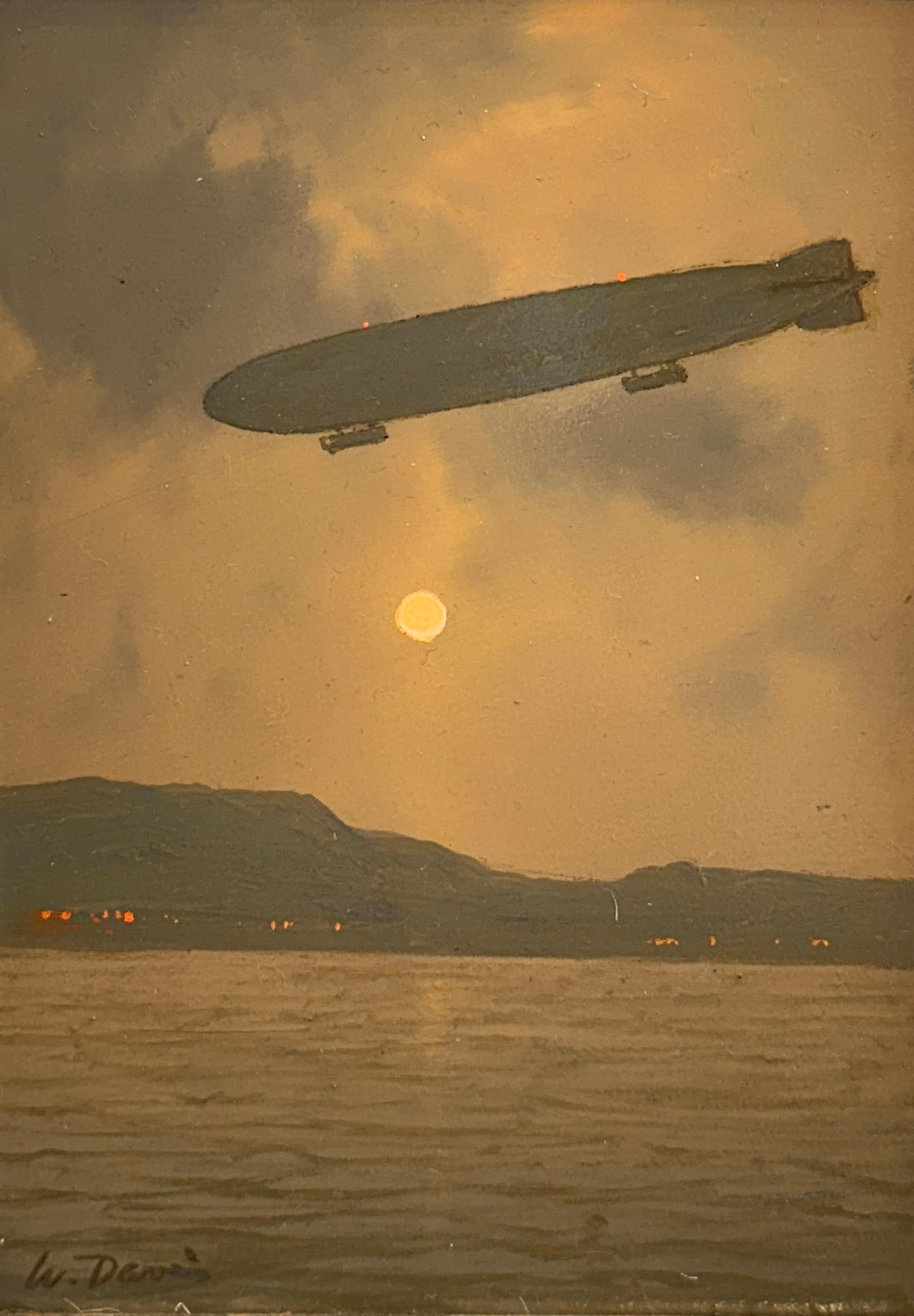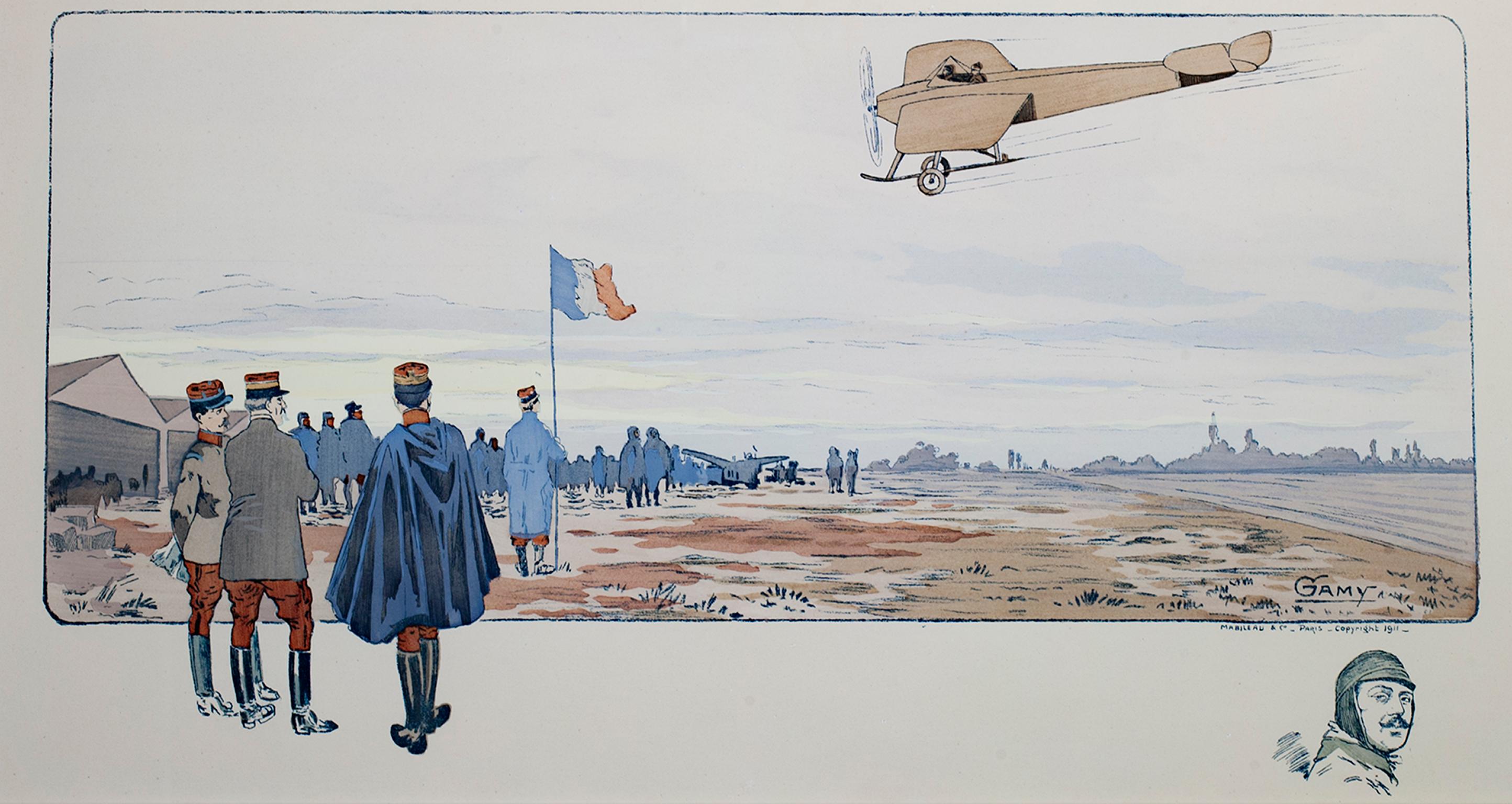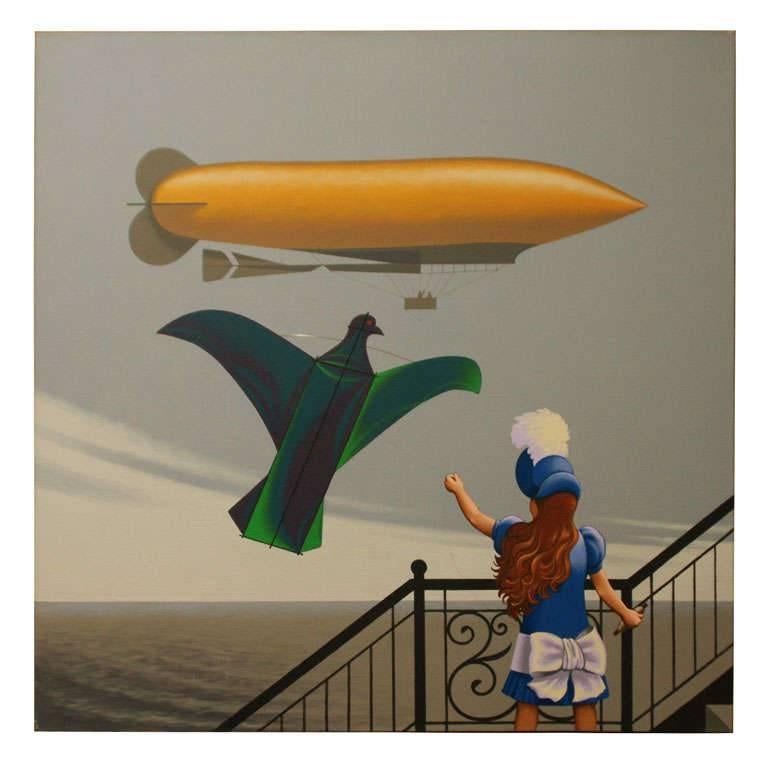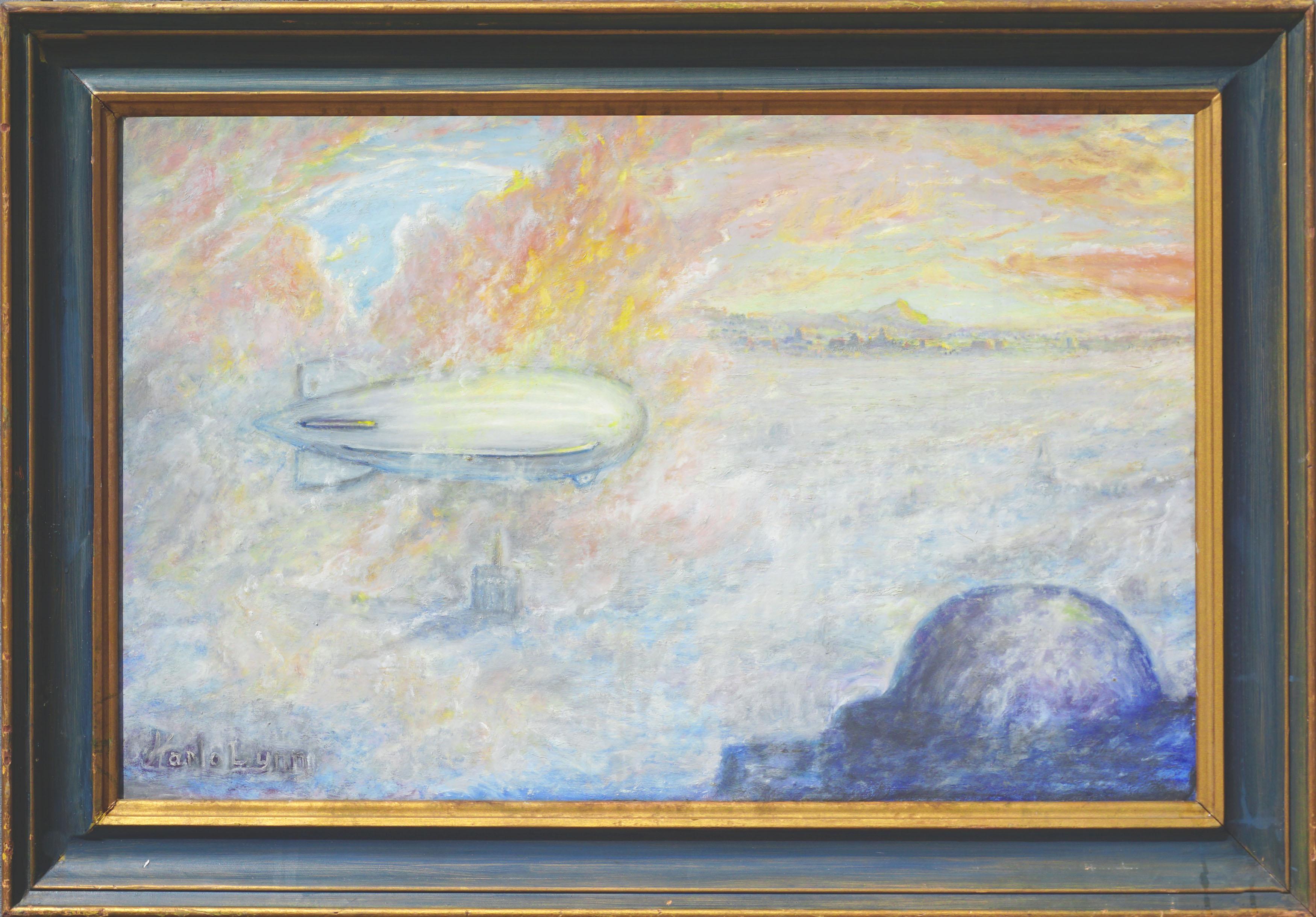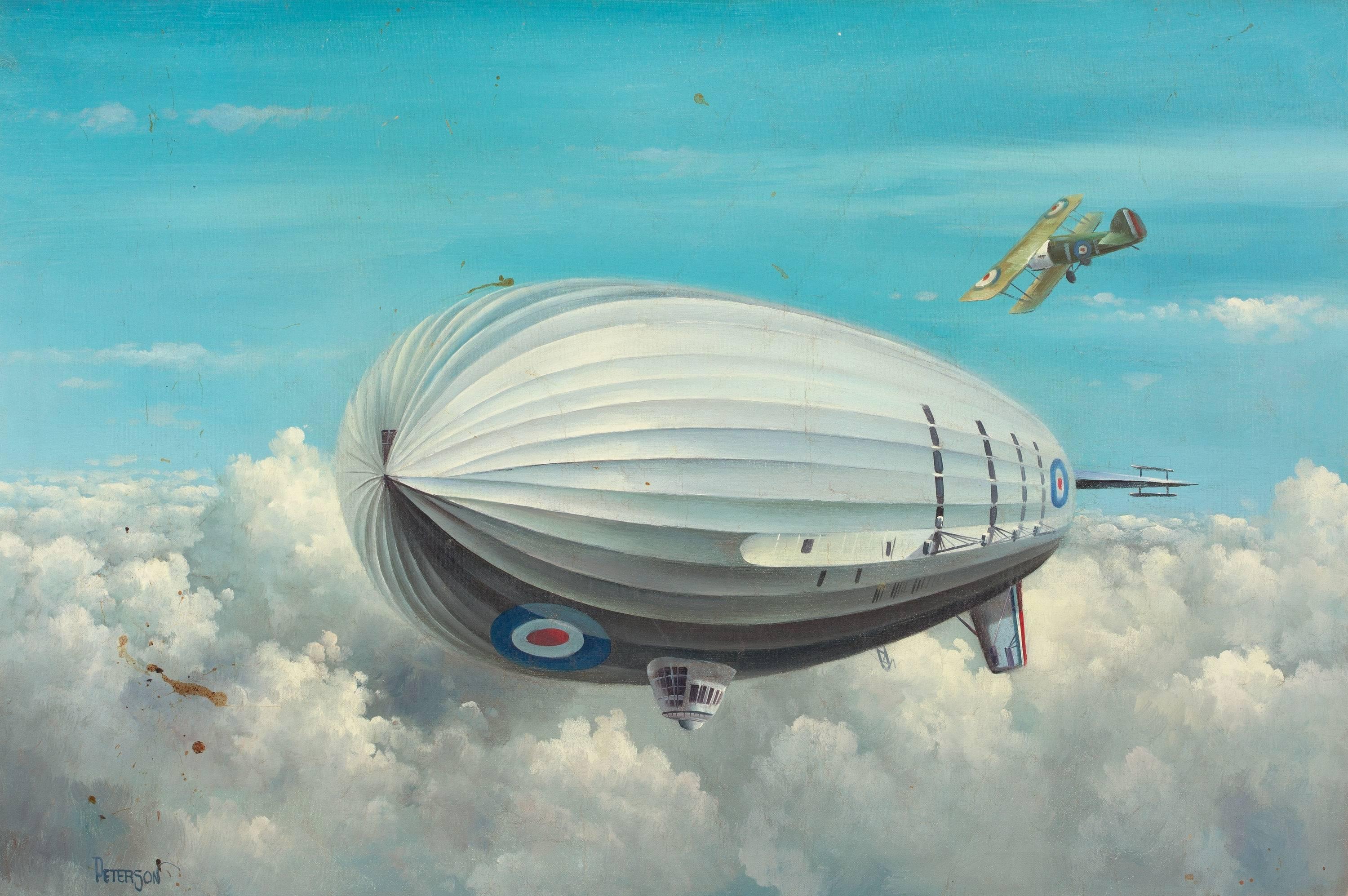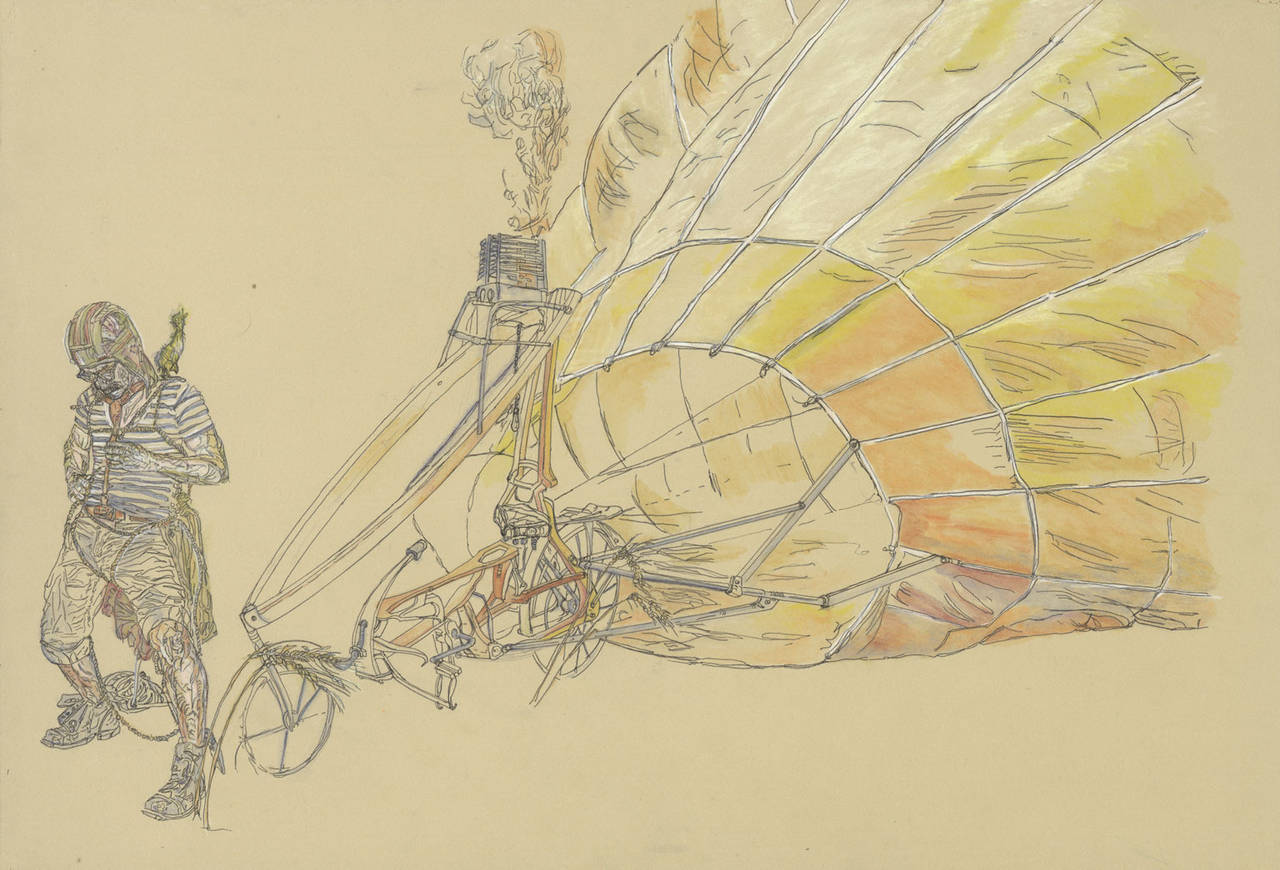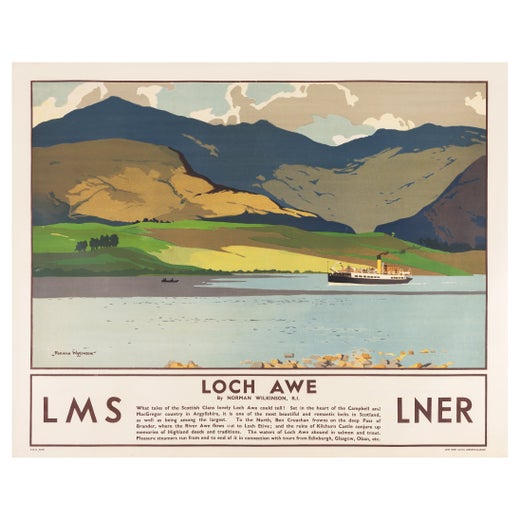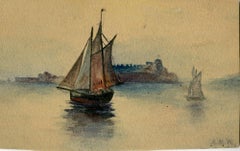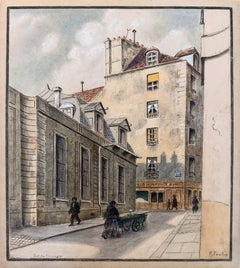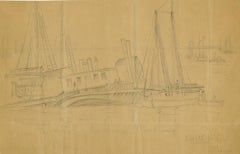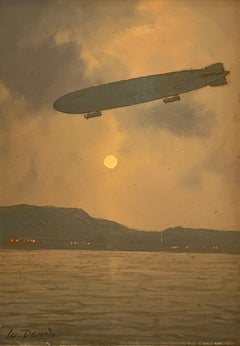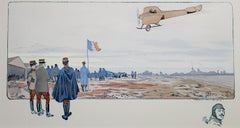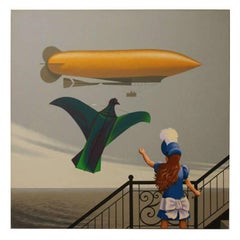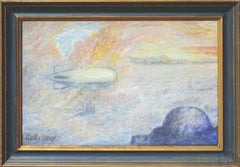Items Similar to Fleurus Airship French Army
Want more images or videos?
Request additional images or videos from the seller
1 of 9
Norman WilkinsonFleurus Airship French Army1912
1912
$2,400
£1,811.21
€2,073.57
CA$3,384.80
A$3,716.08
CHF 1,938.69
MX$44,969.78
NOK 24,298.45
SEK 22,895.53
DKK 15,478.62
About the Item
A portait of the first Allied airship to perform a bombing raid from the sky by a celebrated artist whose work hung on the Titanic.
Watercolor and ink on heavy wove watercolor paper, 10 5/8 x 15 inches (270 x 380 mm). Signed in black watercolor in the lower right image area. In very good condition with minor surface soiling on the verso. Titled "Verdun" in pencil on the verso in the artist's hand. Adhered on the verso to matboard at the extreme margins with non archival tape. Presented handsomely in a simple, period maple frame. Titled, dated, inscribed and initialed by the artist on a label on the frame back.
Born in Cambridge in 1898 and educated at Southsea School of Art, Norman Wilkinson is known for his graphic art, specifically his British Railway poster images, and also for something quite incredible; Wilkinson revolutionized the art of naval camouflage. Having been assigned to submarine patrols in Dardanelles, Gallipoli, and Gibraltar during WWI as a member of the Royal Navy Volunteer Reserve, Wilkinson was deeply troubled by the unprecedented success the German submarine fleet had torpedoing British ships. He hoped to find a solution to this gaping vulnerability, and in a lightning bolt moment, he had an epiphany that would change everything. Wilkinson says in his autobiography, A Brush With Life (Seeley, 1969), that he realized a ship could be painted to hide its shape against the sea and sky. In his own words, Wilkinson states that the hull of a ship could be camouflaged "not for low visibility, but in such a way as to break up her form and thus confuse a submarine officer as to the course on which she was heading." After some preliminary testing, the theory Wilkinson called "dazzle camouflage" was accepted by British Admiralty and Wilkinson was placed in charge of the naval camouflage unit. The unit, which was headquartered in the basement of the Royal Academy of Arts, consisted of Wilkinson and about two dozen "camoufleurs;" they were artists, students, model makers and consultants, including a zoologist. The dazzle schemes were tested on models and then distributed to artists who were stationed at the docks, where the ships would be painted. At the end of the war Wilkinson was formally declared the inventor of dazzle camouflage and awarded for his contribution.
Wilkinson went on to enjoy a long and celebrated career as a painter of maritime scenes, naval vessels, and warships. He served as the president of the Royal Institute of Painter in Water Colours (RI) from 1936 until 1963 (having been elected a member in 1906); he was elected Honourable Marine Painter to the Royal Yacht Squadron in 1919, and he was a member of the Royal Society of British Artists, the Royal Institute of Oil Painters, the Royal Society of Marine Artists, and the Royal Scottish Society of Painters in Watercolour. In 1918 he was appointed an Officer of the Order of the British Empire (OBE), and a Commander of the Order (CBE) in 1948. In January 1920 he was appointed knight (chevalier) of the Belgian Order of the Crown.
Among the many notable points of interest regarding Wilkinson's career is that his painting Plymouth Harbour, which was commissioned by Cunard White Star Lines for the first class smoking room of the RMS Titanic, was lost at sea when it perished with the ship. Wilkinson had also created a comparable painting entitled The Approach to the New World, which hung in the same location on the Titanic's sister ship, the RMS Olympic. This work may be seen in the 1958 film A Night to Remember in scenes aboard the Titanic, where is served as the stand-in for Plymouth Harbor.
About the Fleurus:
At the outset of WWI in 1914, French airships were made entirely out of non-rigid materials, and it was one of these vessels that would become the first aircraft to carry out an Allied bombing raid from the sky. This was the Fleurus, which had been constructed in the shop at Chalais-Meudon two years earlier in 1912, and the historic raid was the Battle of Verdun.
The gondola and engine of the Fleurus (or C.B.V. as it was officially known), both designed by Clement-Bayard (hence the C.B. designation), were extremely efficient and aerodynamic, due to extensive wind tunnel tests conducted at the Eiffel laboratory. During the last months of peacetime before France entered WWI, the Fleurus was widely demonstrated and participated extensively in Army training maneuvers. It was flown from it's base in Pau on September 23, 1914, and completed a flight to Saint-Cyr in 16 hours, maintaining an average speed of 54 km/h (33.7 mph), which was significantly lower than its maximum velocity. The airship maintained an astonishing altitude of 1000 m (3,281 ft) for the duration of the journey.
There being no official air arm of the French forces at the time, the Fleurus was then considered an Army airship, but by 1917 the Fleuris was five years old and obsolete, so was offered to the Navy, which had expanded to include an airforce. The Fleurus, along with another airship, was designated for training exercises along North Africa’s Mediterranean coast. It was here that the Fleurus would see the end of its days. Ironically, the revolutionary airship, which was built using the groundbreaking foundational engineering of fledgeling air warfare, was destroyed by a more modern version of itself. While grounded in a storage hanger The Fleurus was reduced to ashes in an air raid fire in June of 1918.
The French national insignia, seen here in Wilkinson's painting, had not been adopted at the time of the Fleurus' first flight, but when it was introduced, the Fleurus I C.B.V. was one of the earliest in France to be thus marked. The 1912 Fleurus I airship was commemorated on a Korean postage stamp in 1979.
- Creator:Norman Wilkinson (1878 - 1971, British)
- Creation Year:1912
- Dimensions:Height: 10.625 in (26.99 cm)Width: 15 in (38.1 cm)
- Medium:
- Movement & Style:
- Period:
- Condition:Presented handsomely in a simple, period maple frame.
- Gallery Location:Middletown, NY
- Reference Number:Seller: BH5201stDibs: LU1979210342362
Norman Wilkinson
Born in Cambridge in 1898 and educated at Southsea School of Art, Norman Wilkinson is known for his graphic art, specifically his British Railway poster images, and also for something quite incredible; Wilkinson revolutionized the art of naval camouflage. Having been assigned to submarine patrols in Dardanelles, Gallipoli, and Gibraltar during WWI as a member of the Royal Navy Volunteer Reserve, Wilkinson was deeply troubled by the unprecedented success the German submarine fleet had torpedoing British ships. He hoped to find a solution to this gaping vulnerability, and in a lightning bolt moment, he had an epiphany that would change everything. Wilkinson says in his autobiography, A Brush With Life (Seeley, 1969), that he realized a ship could be painted to hide its shape against the sea and sky. In his own words, Wilkinson states that the hull of a ship could be camouflaged "not for low visibility, but in such a way as to break up her form and thus confuse a submarine officer as to the course on which she was heading." After some preliminary testing, the theory Wilkinson called "dazzle camouflage" was accepted by British Admiralty and Wilkinson was placed in charge of the naval camouflage unit. The unit, which was headquartered in the basement of the Royal Academy of Arts, consisted of Wilkinson and about two dozen "camoufleurs;" they were artists, students, model makers and consultants, including a zoologist. The dazzle schemes were tested on models and then distributed to artists who were stationed at the docks, where the ships would be painted. At the end of the war Wilkinson was formally declared the inventor of dazzle camouflage and awarded for his contribution. Wilkinson went on to enjoy a long and celebrated career as a painter of maritime scenes, naval vessels, and warships. He served as the president of the Royal Institute of Painter in Water Colours (RI) from 1936 until 1963 (elected member in 1906); he was elected Honourable Marine Painter to the Royal Yacht Squadron in 1919, and he was a member of the Royal Society of British Artists, the Royal Institute of Oil Painters, the Royal Society of Marine Artists, and the Royal Scottish Society of Painters in Watercolour. In 1918 he was appointed an Officer of the Order of the British Empire (OBE), and a Commander of the Order (CBE) in 1948. In January 1920 he was appointed knight (chevalier) of the Belgian Order of the Crown. Among many notable points of interest regarding Wilkinson's career is that his painting Plymouth Harbour, which was commissioned by Cunard White Star Lines for the first class smoking room of the RMS Titanic, was lost at sea when it perished with the ship. Wilkinson had also created a comparable painting entitled The Approach to the New World, for the Titanic's sister ship, the RMS Olympic. This work may be seen in the 1958 film A Night to Remember in scenes aboard the Titanic, where is served as the stand-in for Plymouth Harbor.
About the Seller
5.0
Vetted Professional Seller
Every seller passes strict standards for authenticity and reliability
Established in 2004
1stDibs seller since 2022
73 sales on 1stDibs
Typical response time: 7 hours
- ShippingRetrieving quote...Shipping from: Middletown, NY
- Return Policy
Authenticity Guarantee
In the unlikely event there’s an issue with an item’s authenticity, contact us within 1 year for a full refund. DetailsMoney-Back Guarantee
If your item is not as described, is damaged in transit, or does not arrive, contact us within 7 days for a full refund. Details24-Hour Cancellation
You have a 24-hour grace period in which to reconsider your purchase, with no questions asked.Vetted Professional Sellers
Our world-class sellers must adhere to strict standards for service and quality, maintaining the integrity of our listings.Price-Match Guarantee
If you find that a seller listed the same item for a lower price elsewhere, we’ll match it.Trusted Global Delivery
Our best-in-class carrier network provides specialized shipping options worldwide, including custom delivery.More From This Seller
View AllSchooners along the Hudson, West Point Academy in the distance.
Located in Middletown, NY
A serene Hudson River scene by a student of Louis Comfort Tiffany.
Anna May Walling was born in 1881, a native of Goshen, New York. She was a graduate of the Blair Academy, and Prat...
Category
Early 20th Century American Realist Landscape Drawings and Watercolors
Materials
Watercolor, Handmade Paper
Rue de Thorigny, signed F. Feuilloy
Located in Middletown, NY
Graphite and crayon in color with white heightening on cream wove paper, 13 1/2 x 12 1/4 inches (343 x 310 mm) (sheet). In good condition with uniform toning, handling creases, and lightly dog-eared corners.
The building on the left is a hotel particulier in Paris' Marais neighborhood, the Hôtel Salé, which now houses the Musée Picasso.
Category
Late 19th Century French School Landscape Drawings and Watercolors
Materials
Crayon, Graphite, Handmade Paper
Raising the wreck of the steamer Flushing at Hampton Roads, Virginia
Located in Middletown, NY
Likely a study for an illustration for Harper's Weekly, for which Wiser was a Civil War-era illustrator, focusing on shipwrecks and battles occurring along the mid-Atlantic coast.
...
Category
Mid-19th Century American Realist Figurative Drawings and Watercolors
Materials
Archival Paper, Graphite
Chaîne de Aravais (Mountains in the Alps) - French School, drawing, circa 1850
Located in Middletown, NY
A beautiful drawing of the Aravis mountain chain in the Alps, including Mont Blanc, with all of the peaks identified by hand.
Circa 1850
Graphite with white heightening on light card...
Category
Mid-19th Century French School Landscape Drawings and Watercolors
Materials
Cardboard, Color Pencil, Graphite
La Loire
Located in Middletown, NY
Pen and black ink on watermarked Ingres laid paper, 9 1/4 x 12 1/4 inches (234 x 310 mm), signed, dated and titled in brown ink, and initialed and titled in black ink in the lower right corner. Light to moderate age tone and mat tone, and with the signature and notations in brown ink having become quite attenuated, although legible. Presented in a basic black wood frame with a label from the Country Art...
Category
Mid-20th Century American Realist Landscape Drawings and Watercolors
Materials
Handmade Paper, Pen, Ink
Deck of a Man o' War / Le Vauban (cuirassé)
By Paul Leon Jazet
Located in Middletown, NY
Lithograph on Les Lettres et les Arts watermarked cream wove paper with deckle edges, 8 3/4 x 10 1/2 inches (220 x 265 mm), full margins. Signed, titled, and numbered 34/52 in penci...
Category
Late 19th Century French School Figurative Prints
Materials
Handmade Paper, Lithograph
You May Also Like
Cape Cod Marine Artist William R. Davis "Zeppelin"
Located in Rockport, MA
The painting "Zeppelin" by William R. Davis, an oil on board measuring 4 1/2" x 6 1/4", captures the haunting elegance of a dirigible silhouetted against the subdued glow of a settin...
Category
21st Century and Contemporary American Impressionist Landscape Paintings
Materials
Oil
"French Air Show with Remarque of Head of Pilot, " Lithograph & Stencil by GAMY
By Marguerite Montaut
Located in Milwaukee, WI
"French Air Show with Remarque of Head of Pilot" is an original lithograph and stencil print by Marguerite Montaut (GAMY). It depicts an early airplane flying above a crowd of specta...
Category
1910s American Realist Landscape Prints
Materials
Lithograph, Stencil, Ink
French Dirigible in 1906, Painting by Lynn Curlee
By Lynn Curlee
Located in New York, NY
A painting of an early French dirigible in 1906. This was used as the dedication page illustration in Ships of the Air, a book by award winning children's book author and illustrator...
Category
Late 20th Century American Paintings
Materials
Canvas, Acrylic
1930s Zeppelin Over San Francisco Landscape
Located in Soquel, CA
1930s Zeppelin Over San Francisco Landscape
Bright and evocative 1938 painting of burning Zeppelin by Ethel Grace Arpin Harlo Lynn (American 1881-1960). This was original painting w...
Category
1930s American Realist Landscape Paintings
Materials
Metal
Zeppelin Airship
Located in Fort Washington, PA
Medium: Oil on Canvas
Dimensions: 24.50" x 36.00"
Signature: Signed Lower Left
Category
20th Century Landscape Paintings
Materials
Canvas, Oil
$2,400
Balloon, Flying Machine, Drawing, Work on Paper, Ink, Watercolor, Tan, Yellow
By Krzysztof Pastuszka
Located in Riverdale, NY
Balloon is an original Ink and Watercolor Pencil drawing on paper. It is 16x24, unframed. It is an invented flying machine idea imagined by Pastuszka. As the bicycle is pedaled, t...
Category
2010s Contemporary Figurative Drawings and Watercolors
Materials
Paper, Ink, Color Pencil
More Ways To Browse
French World War I Posters
Antique Bombs
British Ships
Royal Marines
Army Painting
Scottish Watercolor
Scottish Watercolour
British Railway Poster
Wwi French
Titanic Antique
Cunard Antique
Antique Airship
Cunard White Star
Rms Ship
Rms Olympic
Original Art Sketch
Costume Drawings
18th Century Watercolor And Ink Paintings
